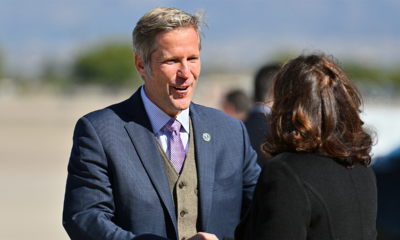Alaska
Takeaways from AP's reporting on challenges to voting in Alaska Native villages
KAKTOVIK, Alaska — The right to vote is considered sacrosanct in the U.S., but it isn’t always so in the tiny, remote Native villages across Alaska.
In these far-flung locations — well off any connected road systems, often accessible only by boats or small planes — challenges to voting abound. Mail and phone service can be unreliable, with severe storms or worker illness causing delays. Sometimes the polls simply don’t open if there’s no one trained to serve as an election worker, or if they don’t show up after being hired or quit before an election.
The result? Hundreds of people can be disenfranchised. That would shock politicians, voters and activists in any swing state, but it’s garnered relatively little attention outside the 49th state.
The Associated Press sent journalists in early October to one village above the Arctic Circle where the precinct failed to open for the August primary this year — Kaktovik, on an island just off the northern coast of Alaska — to take a closer look at the hurdles facing Alaska Native voters. Here are some takeaways from the AP’s reporting.
A lack of poll workers
Recruitment and retention of poll workers has been an ongoing problem statewide for the Alaska Division of Elections, but it can be especially challenging in Native villages, where the cost of goods is high and populations are small.
George Kaleak, a whaling captain and community leader in Kaktovik, blames insufficient pay as well as timing: The August primary arrives when many people are out hunting and fishing, on vacation or preparing for the upcoming whaling season.
Poll workers in Alaska can make $20 an hour, with precinct chairs, who oversee polling sites they’re assigned to, earning slightly more. Workers must commit to working a 16-hour day or to working a split shift, and they must attend a four- to five-hour paid training session.
A sign seeking election help is displayed on the bulletin board in the community building in Kaktovik, Alaska, Wednesday, Oct. 16, 2024. Credit: AP/Mark Thiessen
Among the ways the state has tried to boost interest is a “youth at the booth” program, which seeks to involve older teenagers in working elections.
In Kaktovik, recent high school graduate Edwin Solomon has been considering it. He didn’t vote in the primary and looks at voting in the general election as his “first step into adulthood.”
A recurring problem
Polls not opening has been a recurring problem in rural Alaska. During the August primary this year, precincts in Wales and Kaktovik failed to open. They opened late in several other villages. In Anaktuvuk Pass, the polling place didn’t open until about 30 minutes before closing time; just seven of 258 registered voters there cast ballots in person.
In the 2022 primary, Tununak and Atmautluak didn’t open when workers failed to show up. Two others — Holy Cross and Venetie — didn’t have enough poll workers, but voters were able to cast absentee ballots in person.
A villager walks through the snow in Kaktovik, Alaska, Monday, Oct. 14, 2024. Credit: AP/Lindsey Wasson
In that year’s general election, polls in the villages of Teller and Nuiqsut didn’t open until about 3:30 p.m.
Alaska allows absentee voting, but that can present its own challenges given the sometimes questionable reliability of mail delivery in rural Alaska.
The U.S. Justice Department, which enforces federal laws that protect the right to vote, declined to comment about polling places failing to open in rural Alaska. But for years, pursuant to a court order, it has monitored elections in the state to ensure polling places provide language assistance to Alaska Native voters.
What’s at stake?
Alaska’s lone representative in the U.S. House is Democratic Rep. Mary Peltola — the first Alaska Native elected to Congress. She’s facing Republican Nick Begich in a tight race that will help determine which party controls the House.
Peltola is popular among Alaska Native voters and was endorsed this month by the Alaska Federation of Natives, the largest statewide Native organization in Alaska. She has suggested that the race with Begich could be decided by “dozens of votes,” making the possible implications of any voter disenfranchisement significant.
Is it being addressed?
State, regional and local officials all say they are trying to ensure everyone can vote in the Nov. 5 election. In a written statement, Carol Beecher, director of the Alaska Division of Elections, called her agency “highly invested in ensuring that all precincts have workers and that sites open on time.” She acknowledged it can be difficult to find temporary workers to help run elections in remote villages.
Michelle Sparck, with the nonprofit Get Out The Native Vote, said her agency has partnered with another organization and has found 11 volunteers who have been trained to work elections and are willing to fly to villages, if needed, next week. One is already committed to Craig, a community of about 1,000 people — about 17% Native — on Prince of Wales Island in southeast Alaska.
The North Slope Borough — akin to a county government in other parts of the U.S. — said it also is prepared to send staffers to Kaktovik or other villages that might need help opening precincts if the state fails to hire anyone. The borough, which includes Kaktovik, covers a vast swath of tundra nearly the size of Oregon.

Alaska
Rivers Turn Bright Orange in Alaska

Some of Alaska’s scenic rivers and streams look downright apocalyptic this year because they turned a flagrant orange color — but it’s not due to local pollution, according to scientists at the National Oceanic and Atmospheric Administration (NOAA).
In actuality, the orange tinted water is rust, released as the frozen ground in Alaska thaws out due to unchecked greenhouse gasses driving global warming. And it’s leaking into the state’s waterways, according to NOAA’s annual report on the Arctic region, where it’s posing a danger to local wildlife, residents and commercial fisheries.
The day-glo rivers are also a bright orange flag that the Arctic is warming faster than the rest of the world. The massive defrosting is also anticipated to increase sea levels and screw up weather patterns, according to scientists who talked to NPR.
“When the Arctic thaws and warms, it’s having an impact on the global climate,” Matthew Druckenmiller, lead author of the report and senior scientist with the Boulder, Colorado-based National Snow and Ice Data Center, told the broadcaster.
The planet is already showing signs of distress from global warming, such as large-scale forest fires and extreme summer temperatures outside the Arctic, which Druckenmiller described as a giant fridge for the planet.
“The Arctic is warming several times faster than Earth as a whole, reshaping the northern landscapes, ecosystems, and livelihoods of Arctic peoples,” reads the NOAA report. “Also transforming are the roles the Arctic plays in the global climate, economic, and societal systems.”
Zooming back to Alaska, people started noticing the orange waterways in 2018, according to NPR.
“ We heard from people who live in the region — pilots who are often flying over, people in the national parks,” US Geological Survey research hydrologist Josh Koch told the broadcaster.
As temperatures heats up in the most remote parts of Alaska, permafrost — ground that usually stays continuously frozen — is melting, and that’s unlocking iron in the soil, which oxidizes from exposure to water and air, causing rivers and streams to turn orange. Surveys revealed that this contamination is far reaching, covering hundreds of miles of terrain in Alaska.
“It’s often not orange until it reaches the stream, and then all the iron and other metals can precipitate and create this iron staining,” Koch added.
It’s not clear if residents are being harmed from the polluted water, but local scientists are monitoring the situation, NPR reports.
The other problem with these rusty rivers is that they increase the acidity level in the water, according to the NOAA report, and this may harm fish like Dolly Varden char, whose juvenile offspring have experienced a sharp decrease in numbers most likely due to iron in its aquatic habitat. And that’s pretty bad for everybody in Alaska.
“The food chain is connected to the lives of people living in the Arctic,” Druckenmiller said.
More on climate change: Melting Glacier in Alaska Floods State Capital
Alaska
Winter Solstice celebration takes over Cuddy Park

ANCHORAGE, Alaska (KTUU) – On the darkest weekend of the year, Alaskans gathered at Cuddy Park to mark the moments before daylight finally begins its slow return.
To celebrate, the Municipality held its annual winter solstice festival, inviting everyone for an evening of cold-weather fun.
”Some of the highlights, of course, are ice skating at the oval right over there, some holiday music, we have Santa and Mrs. Claus wandering around, we are going to have some reindeer here,” Anchorage Parks and Recs Community Engagement Coordinator, Ellen Devine, said.
In addition to seeing reindeer, folks could take a ride around the park in a horse-drawn carriage or sit down and watch a classic holiday film provided by the Alaska Bookmobile.
Despite the frigid temperature, people made their way down to the park to partake in some festive cheer.
“It is my first time in Anchorage,” attendee Stefan Grigoras said. “It’s beautiful, it is a little bit cold, I’m not going to lie, but I want to take a picture with the reindeer.”
Grigoras, like many, took part in the free hot chocolate and took his photo with St. Nick and Mrs. Claus, who were seen wandering around bringing joy to all.
“[The kids] get so excited and, you know, you have everything from run over and almost knock us down with hugs to not even wanting to come near us, and it’s just a fun combination of all that,” Mrs. Claus said.
Some of those kids were Logan and Keegan, who were out and about with their parents, Samantha and Trevor. The two kids asked for things that every child is sure to want.
“A monster truck,” Logan said.
“Bingo,” Keegan said.
”Like Bluey and Bingo,” Samantha clarified for Keegan.
The young family is originally from Arkansas and is excited to be a part of a thriving community.
“I love Anchorage’s community. There’s so many community events, and especially as a young family, it makes me really excited to get together and get to know people,” Samantha said.
As the festivities continued into the night, a familiar holiday message could be heard.
”Merry Christmas, ho, ho, ho,” the Clauses yelled!
“Merry Christmas,” Logan and Keegan said.
See a spelling or grammar error? Report it to web@ktuu.com
Copyright 2025 KTUU. All rights reserved.
Alaska
Opinion: You get what you pay for — and Alaska is paying too little

Most Alaskans, perhaps even most Americans, have a knee-jerk reaction to taxes. They affect citizens in a sensitive area — their pocketbook. Perhaps a little analysis and thought could change this normal negative reaction.
It is clear, even to the stingiest among us, that Anchorage and Alaska need more income. Our severely underfunded public schools, decreasing population — called “outmigration” these days — underfunded police force, deteriorating streets and highways, underfunded city and state park budgets, and on and on, are not going to fix themselves. We have to pay for it.
Public schools are the best example. Do you want your first grader in a classroom with 25-plus students or your intermediate composition student in a class with 35-plus students? What if the teacher needs four to five paragraphs per week per student from two such classes? Who suffers? The teacher and 70 students. It’s not rocket science — if you minimize taxes, you minimize services.
I was an English teacher in Anchorage and had students coming into my classroom at lunch for help. Why? They were ambitious. Far more students who wanted and needed help were too shy, too busy or less motivated. With smaller class sizes, those students would have gotten the help in class.
Some Alaskans resent paying taxes that help other people’s children. They often say, “But I don’t have any kids in school!” The same attitude is heard when folks say, “The streets in our neighborhood are fine.” Taxes are not designed to help specific taxpayers; they are, or should be, designed to help the entire community. And we are a community.
As well, lots of people get real excited by sales taxes, especially those who have enough income to buy lots of stuff. They argue that, on balance, sales taxes are unfair — they are regressive. That means that individuals with less income pay a higher percent of their income than individuals with a higher income, and this is true. It is minimized by exempting some expenses — medical care, groceries and the like.
A recent opinion piece published in the Anchorage Daily News explained the disadvantages of a regressive tax. In doing so, the author made an excellent argument for using a different kind of tax.
The solution is to use an income tax. With an income tax, the regulations of the tax can prevent it from being regressive by requiring higher tax rates as individual incomes increase. Alaska is one of only eight or nine states with no state income tax. For those folks all worked up about regressive sales taxes, this is the solution.
Any tax that most folks will accept depends on people seeing themselves as part of the same community. That’s not always obvious these days — but it doesn’t change the bottom line: We still have to pay our way.
Tom Nelson has lived in Anchorage more than 50 years. He is a retired school teacher, cross country ski coach, track coach, commercial fisherman and wilderness guide.
• • •
The Anchorage Daily News welcomes a broad range of viewpoints. To submit a piece for consideration, email commentary(at)adn.com. Send submissions shorter than 200 words to letters@adn.com or click here to submit via any web browser. Read our full guidelines for letters and commentaries here.
-

 Iowa6 days ago
Iowa6 days agoAddy Brown motivated to step up in Audi Crooks’ absence vs. UNI
-

 Iowa1 week ago
Iowa1 week agoHow much snow did Iowa get? See Iowa’s latest snowfall totals
-

 Maine4 days ago
Maine4 days agoElementary-aged student killed in school bus crash in southern Maine
-

 Maryland6 days ago
Maryland6 days agoFrigid temperatures to start the week in Maryland
-

 Technology1 week ago
Technology1 week agoThe Game Awards are losing their luster
-

 South Dakota6 days ago
South Dakota6 days agoNature: Snow in South Dakota
-

 New Mexico4 days ago
New Mexico4 days agoFamily clarifies why they believe missing New Mexico man is dead
-

 World1 week ago
World1 week agoCoalition of the Willing calls for transatlantic unity for Ukraine























